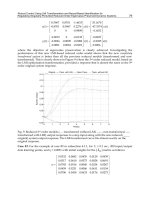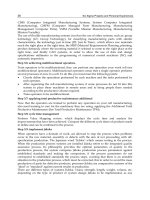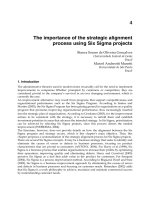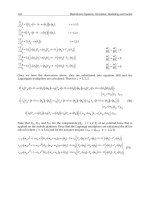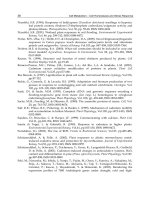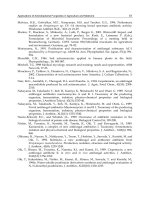Composites Manufacturing - Materials, Product, and Process Engineering Part 4 ppt
Bạn đang xem bản rút gọn của tài liệu. Xem và tải ngay bản đầy đủ của tài liệu tại đây (74.57 KB, 4 trang )
© 2002 by CRC Press LLC
comparison should be based on final product cost, not on the cost of initial
materials. For the filament winding process, the raw material cost is 3 to 8
times cheaper than the graphite/epoxy prepreg used in the roll wrapping
process; but for large production volume and higher performance, the roll
wrapping process is selected for making golf shafts.
3.4 Material Property Information
Materials data enters at various stages of the design process, but the level
of accuracy required on material property information differs at each stage.
In the initial stage of the design process (conceptual stage), approximate data
for wide range of materials is gathered and design options are kept open.
Table 3.1 and Tables 2.1 and 2.2 in Chapter 2 provide basic information about
the various types of composite materials. This information can be helpful in
the preliminary assessment of these materials. In the preliminary stage, a
designer identifies which matrix material and fibers are more suitable. For
example, for a certain application, polyester resin might be a suitable choice;
and for another application, epoxy may be a more suitable choice. Similarly,
for a manufacturing process, one specific type of material system may be
more appropriate than the other. For a manufacturing process, if the engineer
selects a particular raw material, the engineer needs to clearly write down
key characteristics of the selected raw material. For example, if prepreg
material is selected for an application, then the designer has to identify the
following parameters:
• Type of prepreg: unidirectional or woven fabric prepregs
• Fiber type (carbon, glass, Kevlar, etc.)
• Woven pattern (plain weave, satin weave, etc.)
• Width of the tape
• Resin content
• Areal weight
• Ply physical and mechanical properties
Similarly the manufacturing engineer has to specify tack, drape, cure cycle,
processing temperature, gel time, flow characteristics, and more for the
application.
Materials property information can be obtained from published literature,
suppliers’ brochures, and handbooks. In the published literature, single-value
data is given on the property without any standard deviation. During the final
design process, more detailed information on material property with high
precisions is required.
© 2002 by CRC Press LLC
comparison should be based on final product cost, not on the cost of initial
materials. For the filament winding process, the raw material cost is 3 to 8
times cheaper than the graphite/epoxy prepreg used in the roll wrapping
process; but for large production volume and higher performance, the roll
wrapping process is selected for making golf shafts.
3.4 Material Property Information
Materials data enters at various stages of the design process, but the level
of accuracy required on material property information differs at each stage.
In the initial stage of the design process (conceptual stage), approximate data
for wide range of materials is gathered and design options are kept open.
Table 3.1 and Tables 2.1 and 2.2 in Chapter 2 provide basic information about
the various types of composite materials. This information can be helpful in
the preliminary assessment of these materials. In the preliminary stage, a
designer identifies which matrix material and fibers are more suitable. For
example, for a certain application, polyester resin might be a suitable choice;
and for another application, epoxy may be a more suitable choice. Similarly,
for a manufacturing process, one specific type of material system may be
more appropriate than the other. For a manufacturing process, if the engineer
selects a particular raw material, the engineer needs to clearly write down
key characteristics of the selected raw material. For example, if prepreg
material is selected for an application, then the designer has to identify the
following parameters:
• Type of prepreg: unidirectional or woven fabric prepregs
• Fiber type (carbon, glass, Kevlar, etc.)
• Woven pattern (plain weave, satin weave, etc.)
• Width of the tape
• Resin content
• Areal weight
• Ply physical and mechanical properties
Similarly the manufacturing engineer has to specify tack, drape, cure cycle,
processing temperature, gel time, flow characteristics, and more for the
application.
Materials property information can be obtained from published literature,
suppliers’ brochures, and handbooks. In the published literature, single-value
data is given on the property without any standard deviation. During the final
design process, more detailed information on material property with high
precisions is required.
© 2002 by CRC Press LLC
4
Product Development
4.1 Introduction
Every year, hundreds of new materials and products are launched into the
marketplace. Material suppliers are coming up with new reinforcements,
resins, and prepreg materials to meet various customer needs. The materials
not available in the past have become the material of choice today. New
epoxy-based prepregs with a shelf life of 1 year at room temperature are
available. Preform manufacturers are coming up with new braiding technol-
ogies and preform materials for increased manufacturing feasibility. Honey-
comb and core suppliers are introducing new core materials to meet new
market needs. Sporting goods manufacturers, boat builders, and consumer
industries are launching new products into the marketplace to maintain their
competitive position. The automotive industry is replacing steel and alumi-
num parts with composite materials for fuel and weight savings. The aero-
space industry is utilizing more and more composite materials to increase
payload capacities and fuel savings.
The need for new material/product development has increased rapidly
with the improvement in technology and globalization of the market. Com-
panies are struggling to keep their competitive position in the marketplace
by improving their product quality and performance. Customers are
demanding better products at lower cost. Product life has decreased signif-
icantly. There has been greater demand for reducing the product develop-
ment cycle time. It is said that the companies that introduce a new product
first onto the market get more than 50% of the market share.
Understanding the product development process is very important in the
fabrication of a good quality part. Major automotive, aerospace, and com-
puter companies follow a systematic approach for the development of a new
product/model or a specific part. Product fabrication is one element of a
product development process. This chapter explains all the important ele-
ments of a product development process.
© 2002 by CRC Press LLC
5
Design for Manufacturing
5.1 Introduction
Companies are constantly being challenged to find means to do things better,
faster, and cheaper. Companies can no longer overdesign the product, nor
can they afford a lengthy product development cycle time. The products can
no longer be viewed individually, and designers can no longer pass the
engineering concept to the manufacturing engineer for finding the ways to
make it. The design engineer and manufacturing engineer need to work
together to come up with a best design and manufacturing solutions for
fabricating the products cost-effectively. For example, if design and manufac-
turing engineers work separately to create the design of the outer body panels
of automobiles, the manufacturing engineer will come up with a flat or square
box-like product that is cheaper and quicker to make, but no one would buy
it. On the other hand, the design engineer will come up with a design that
is creative, eye-catching, and satisfies all customer needs and requirements,
but it would be unaffordable. In either case, the product will not sell.
To be competitive, the product needs to be designed in a minimum amount
of time, with minimum resources and costs. To meet current market needs,
several philosophies, such as design for manufacturing, design for assembly,
design for quality, design for life cycle, and concurrent design, are being
developed. The primary aim of these philosophies is to think about the
manufacturing, assembly, quality, or life-cycle needs
during
the design pro-
cess. This is achieved by working concurrently in a concurrent engineering
environment to avoid later changes in the design.
A product can be designed in many ways to meet functional, performance,
and other requirements. Therefore, different organizations come up with
different design concepts to meet the same application needs. The solution
for an application depends on how the problem is defined to the designer as
well as the knowledge and creativity of the designer. Because there are many
design solutions to a problem, the question arises as to how to know which
design is the best solution. It is also possible that there may be other designs
that may be better than the realm of the designer. Design for manufacture is



